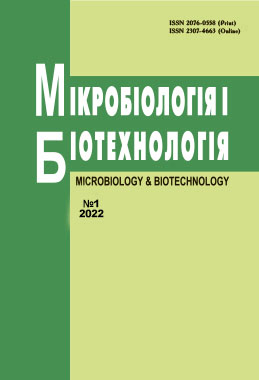БІОЦИДНА ДІЯ МЕТАБОЛІТІВ ШТАМІВ STREPTOMYCES GLOBISPORUS 3-1 і STREPTOMYCES CYANOGENUS S136
DOI:
https://doi.org/10.18524/2307-4663.2022.1(54).254323Ключові слова:
біоцидна дія, Clavibacter michiganensis subsp. michiganensis, бактеріальний рак помідорів, StreptomycesАнотація
Реферат
Актуальним є дослідження біоцидної дії метаболітів стрептоміцетів-антагоністів до збудника бактеріального раку помідорів та на плодовитість рослини-хазяїна.
Мета. Визначити дію метаболітів штамів Streptomyces globisporus 3-1 та Streptomyces cyanogenus S136 проти фітопатогенну Clavibacter michiganensis 102 in vitro та на схожість насіння, ріст та урожайність помідорів in vivo.
Методи. Застосовували мікробіологічні методи в лабораторних умовах та описово-порівняльний аналіз росту та розвитку помідорів в умовах теплиці.
Результати. Метаболіти S. globisporus 3-1 та S. cyanogenus S136 пригнічувати ріст фітопатогену C. michiganensis 102 з зонами 45 та 35мм in vitro, відповідно. Передпосівна обробка метаболітами продуцентів S. globisporus 3-1 та S. cyanogenus S136 насіння помідорів сорту Ляна знижувала схожість на 27% для обох, призводила до дефектів форм листя та стерильності рослин, відповідно. Обробка інфікованого насіння метаболітами обох штамів стрептоміцетів не покращували схожість, ріст та урожайність в порівнянні з розвитком рослин з інфікованого насіння, хоча вони візуально не мали дефектності та стерильності та ознак бактеріального раку помідорів в умовах теплиці.
Висновок. Встановлено, що метаболіти штамів S. globisporus 3-1 та S. cyanogenus S136 мають біоцидну дію до фітопатогену C. michiganensis 102 invitro та на помідори сорту Ляна в умовах теплиці.
Посилання
Biliavska LA, Efimenko TA, et al. Identification and antagonistic properties of the soil streptomycete Streptomyces sp. 100. Microbiol. Z. 2016; 78(2):61-73 (in Russian) doi: https://doi.org/10.15407/microbiolj78.02.061
Gvozdyak RI, Moroz SM, Yakovleva LM, Chernenko EP.Etiology of mass disease of tomatoes at the farms of Ukraine. Mīkrobiol. Z. 2009; 71(5):33-40 (in Ukrainian) http://nbuv.gov.ua/UJRN/MicroBiol_2009_71_5_7
Gromyko O. Antagonistic properties of actinomycetes isolated from the rhizosphere of celandine large Chelidonium majus. Bulletin of Lviv University. Biological series. 2014; 64:279–286 (in Ukrainian) Available from:file:///D:/Downloads/8222-16122-1-PB%20(1). pdf
Electronic resource – Available from: https://itd.rada.gov.ua/billInfo/Bills/pubFile/442335
Electronic resource – Available from: https://valest.com.ua/skruchujutsja-listja-na-pomidorah/
Korynevska AV. Mechanisms of cytotoxic action of landomycin E on tumor cells in vitro. Dissertation for the degree of Biological Sciences Candidate. L. 2009; 126p (in Ukrainian)
Lavrinchuk VYA, Kotenko KA et al. Obtaining and characterization of mutants of Streptomyces globisporus 1912 with increased biosynthesis of landomycin E. Microb.Z. 2011.73 (6):31-35 (in Ukrainian) doi: 10.20535/1810-0546.2017.3.96444
Polishchuk LV, Hanusevych II, Matseliukh BP. The antitumor action of antibiotics produced by Streptomycesglobisporus 1912 studied in a model of Guerin's carcinoma in rats. Mikrobiol.Z. 1996; 58(2):55-8 (in Ukrainian)
Romanyuk LB, Kravets N.Ya. et al. Antibiotic resistance of opportunistic pathogens: relevance, conditions of occurrence, ways to overcome. 2019; (in Ukrainian) doi: 10.11603/1681-2727.2019.4.10965
Todosiychuk TS, Fedorenko VO, Molochko MV, Gromyko OM. Development of conditions for deep biosynthesis of the antibiotic landomycin A. KPI. 2017; (3):82-88 (in Ukrainian)
Electronic resource – Available from: https://www.intechopen.com/chapters/570193.
Electronic resource – Available from: https://wiki.bugwood.org/Kings_medium_B
Golembiovska SL, Bambura OI, et al. Antagonism of Streptomyces species 26UF7and 35NG3 to Clavibacter michiganensis subsp. michiganensis102. Mikrobiol.Z. 2020; 82(2): 60-66 doi: https://doi.org/10.15407/microbiolj82.02.060 (in Ukrainian).
Henkel T, Rohr J, Beale JM, Schwenen L. Landomycins, new angucycline antibiotics from Streptomyces sp. I. Structural studies on landomycins A-D. J Antibiot 1990. 43:492–503. doi: 10.7164/antibiotics.43.492.
Lehka LV, Panchuk RR, Berger W, Rohr Ju., Stoika RS. The role of reactive oxygen species in tumor cells apoptosis induced by landomycin A. Ukr. Biochem. J., 2015; 87(5):72-82. doi: https://doi.org/10.15407/ubj87.05.072.
Nandi M, Macdonald J, et al. Clavibacter michiganensis ssp. michiganensis: bacterial canker of tomato, molecular interactions and disease management. Mol Plant Pathol. 2018; 19(8):2036-2050. doi: 10.1111/mpp.12678.
Thapa SP, Pattathil S, et al. Genomic analysis of Clavibacter michiganensis reveals insight into virulence strategies and genetic diversity of a Gram-positive bacterial pathogen. Mol. Plant–Microbe Interact. 2017; 30:786–802. doi: 10.1094/MPMI-06-17-0146-R.
Zhang W, Yang W, Meng Q, Li Y, Liu D. Screening and identification of antagonistic Streptomyces spp. against Clavibacter michiganensis subsp. michiganensis from tomato rhizoshere. Frontiers of Agriculture in China. 2010; 4(2):159–164. doi: https://doi.org/10.1007/s11703-010-0095-x.
##submission.downloads##
Опубліковано
Номер
Розділ
Ліцензія
Авторське право (c) 2022 С. Л. Голембіовська, Л. В. Поліщук, О. І. Бамбура

Ця робота ліцензується відповідно до Creative Commons Attribution-NonCommercial 4.0 International License.
Автор передає журналу (університету) на безоплатній основі невиключні права на використання статті (на весь строк дії авторського права починаючи з моменту публікації, розміщення статті на веб-сторінці журналу, в репозитарії відкритого доступу) без одержання прибутку; на відтворення статті чи її частин в електронній формі (включаючи цифрову); виготовлення ії електронних копій для постійного архівного зберігання; виготовлення електронних копій статті для некомерційного розповсюдження; внесення статті до бази даних репозитарію; надання електронних копій статті в доступі мережі інтернет.
Автор гарантує, що у статті не використовувалися статті або авторські права, які належать третім особам; гарантує, що на момент розміщення статті на веб-сторінці, в репозитарії ОНУ лише йому належать виключні майнові права на статтю, що розміщується; майнові права на статтю ні повністю, ні в частині нікому не передано (не відчуджено), майнові права на статтю ні повністю, ні в частині не є предметом застави, судового спору або претензій з боку третіх осіб.
Автор зберігає за собою право використовувати самостійно чи передавати права на використання статті третім особам.
Автор надає журналу право на використання статті такими способами:
переробляти, адаптувати або іншим чином змінювати її за погодженням з автором; перекладати статтю у випадку, коли стаття викладена мовою іншою, ніж мова, якою передбачена публікація у виданні. Якщо журнал виявить бажання використовувати статтю іншими способами: перекладати, розміщувати повністю або частково у мережі інтернет, публікувати статтю в інших, в тому числі іноземних виданнях, включати статтю як складову частину до інших збірників, антологій, енциклопедій тощо, умови оформлюються додатковою угодою.
Автор підтверджує, що він є автором (співавтором) цієї статті; авторські права на дану статтю не передані іншому видавцю; дана стаття не була раніше опублікована у будь-якому іншому виданні до публікації її журналом.
Публікація праць в Журналі здійснюється на некомерційній основі. Комісійна плата за оформлення статті не стягується.

